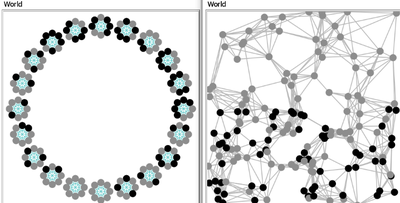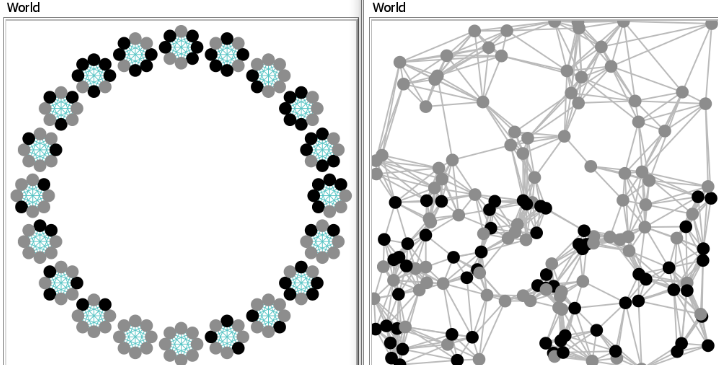Two agent-based models of cooperation in dynamic groups and fixed social networks (1.0.0)
Both models simulate n-person prisoner dilemma in groups (left figure) where agents decide to C/D – using a stochastic threshold algorithm with reinforcement learning components. We model fixed (single group ABM) and dynamic groups (bad-barrels ABM). The purpose of the bad-barrels model is to assess the impact of information during meritocratic matching. In the bad-barrels model, we incorporated a multidimensional structure in which agents are also embedded in a social network (2-person PD). We modeled a random and homophilous network via a random spatial graph algorithm (right figure).

Release Notes
Version 1.0.0 of June 2021
Associated Publications
de Matos Fernandes, C.A., Flache, A., Bakker, D.M., & Dijkstra, J. (2022). A Bad Barrel Spoils a Good Apple: How Uncertainty and Networks Affect Whether Matching Rules Can Foster Cooperation. Journal of Artificial Societies and Social Simulation, 25(1), 6. doi: 10.18564/jasss.4754
Two agent-based models of cooperation in dynamic groups and fixed social networks 1.0.0
Both models simulate n-person prisoner dilemma in groups (left figure) where agents decide to C/D – using a stochastic threshold algorithm with reinforcement learning components. We model fixed (single group ABM) and dynamic groups (bad-barrels ABM). The purpose of the bad-barrels model is to assess the impact of information during meritocratic matching. In the bad-barrels model, we incorporated a multidimensional structure in which agents are also embedded in a social network (2-person PD). We modeled a random and homophilous network via a random spatial graph algorithm (right figure).
Release Notes
Version 1.0.0 of June 2021

